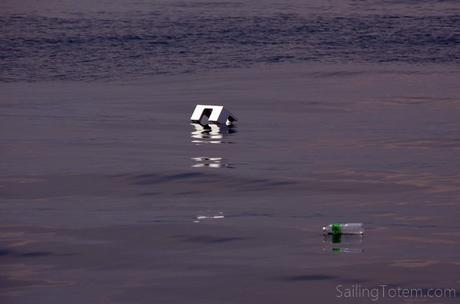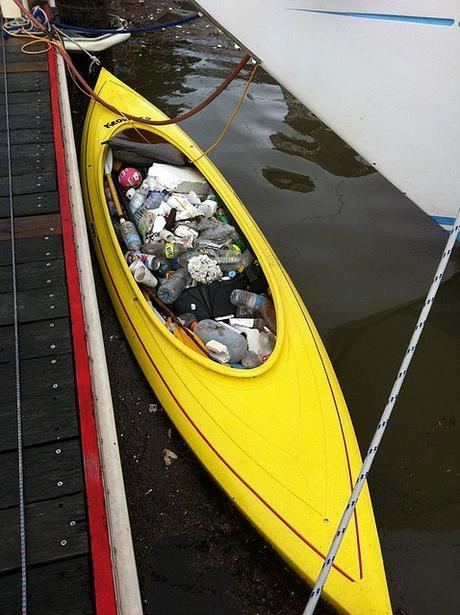
Carefully sealed into the wine bottle was a message from afar. Fisherman in Florida found and read the drift mail, learning that it was from a woman that sailed across the Atlantic Ocean the year before. They contacted the sender and after hearing her message was found, she joyfully related the story to a group of fellow sailors. Her joy was short-lived. The response was not shared enthusiasm but self-righteous, contemptuous clucks. How dare she litter!
Was it really littering, or just slow speed communication? It’s difficult to encounter any sailor who doesn’t have deep respect for the beauty and health of our oceans. While it’s anathema for us now, I remember being young and seeing trash all along the roadside. Then a cultural shift occurred, aided by very effective TV commercials. Trash all but disappeared from the roadways and gutters and waterways and a strong anti-littering mindset set in. Thirty plus years later, seeing someone choose to throw litter on the ground or in the ocean is gut wrenchingly wrong. More than that, it’s depraved!

In Australia, we’d collect trash around the boat in our kayak for disposal
Many people around the world understand that pollution, in all its forms, is harmful to the environment. In Vanuatu for example, near the shadows World War II ruins, schools teach environmental stewardship and village chiefs manage local fisheries to avoid depletion. In Australia, everyone knows the phrase “Clean Up Australia” after the event (and subsequent culture) initiated and promoted by Australian solo sailor, Ian Kiernan.
Unfortunately, in many parts of the world there is no stigma attached to littering, or awareness that polluting is harmful. Pollution in the water is a significant global problem from past and present sources. Even after nearly two years in Southeast Asia, the volume of floating trash we see from Totem is still shocking. Nearly every day, the plastic pollution floating around us would alarm the village chief in Vanuatu or concerned boater in Seattle. It is tragic to watch the daily outflow of plastic trash in the tens of thousands count when anchored off a small Indonesian city. In the wake of a cruise ship plowing the straits of Malacca, the sea of Styrofoam containers and shampoo bottles and bags thrown over the stern is appalling.
At an individual level, it’s not difficult to manage waste on board, even when sailing distances or far from shore. It takes a little practice and little common sense. We wash waste that needs to be stored until proper disposal, so it doesn’t smell. Using a larger bottle to stuff soft and smaller plastic bits inside, you can hold a surprising quantity. Only organic items should go overboard. Even then, MARPOL (the International Maritime Organization’s convention on what can be discharged from ships) combined with common sense dictates disposal should only be where there’s the vast ocean flush, and not a bay or harbor. Burning plastic on the beach is a big no-no, although cruising culture hasn’t quite caught up to that yet. EPA studies now show that the relatively low temperatures of beach or backyard fires (as compared to commercial incinerators) for burning create staggeringly toxic emissions, and not just from plastics. On Totem, we wondered about this, but lacking good information about have had the occasional beach burns on remote areas when there weren’t alternatives. Knowing better now, we hold on to it until there’s another option: if we brought it on, we can wait to bring it off, too.
What’s less recognized by boaters is passive waste, especially by those throwing stones at people casting out glass bottles. Throw a disposable cup overboard in our home port of Eagle Harbor, and anyone in range will give you the evil eye. Soak a bucket of laundry with a splash of bleach that gets poured overboard and no one even looks twice. What about spilling a little gas while refilling the dinghy tank? Or rinsing the boat after using teak cleaner, to keep the deck looking Bristol? We’re pretty much all guilty: bottom paints, solvents, cleaners, and engine exhaust are arguably far worse than a message in a bottle, yet they’re relatively invisible.

the kids in Sydney, Australia, 2011
When these passive pollutants can be seen, we make them disappear. Ever watched someone sprinkle detergent on an “oops” spill of gas or diesel? The detergent acts a surfactant, which is to say it breaks surface tension, causing oil to disperse and sink. It doesn’t make the problem go away, it just makes it invisible. Surfactants make it easier for fish to absorb toxins; concentrations as small as 2 parts per million doubles the chemicals they would normally absorb. In a coral reef, crude oil droplets dispersed with detergent are shown be more toxic than oil undisturbed. Oil kills by suffocating coral polyps; toxins in the oil are an additional poison. The increased surface area of droplets allows additional toxic components to come out, increasing the adverse effect on marine life nearby. When you wash your boat, the runoff that blends accompanying petroleum products and other contaminants with detergent is creating a toxic soup that is destructive to marine life.
What happens when you do the dishes, or wash laundry on board? Phosphates in detergents contribute to explosive growth of algae. Currently a big problem in Florida and the Great Lakes, it depletes water of oxygen, killing fish and aquatic life. Phosphates are banned from household laundry in Washington but still allowed in most dishwasher detergents, and common outside our state. Bleach is worse, and has no place in any routine for laundry or cleaning aboard: the ratio of water to bleach necessary to make it safe for fish is 1 to 312,000.
None of us are benign. We make the best choices we can, but often have limited, outdated, or poor information. At other times, we simply have few options for doing better. So how is a message pitched out into the ocean, even if carried in an inert vessel and unlikely to cause any harm, perceived to be as evil as Styrofoam containers and plastics bags, while boat cleaners stream over the side with impunity?
Aside from being a bad idea, it’s technically illegal to litter or pollute our home waters, and most countries. This is a good thing and clearly ingrained enough to get people debating over the nature of a message in a bottle. But it’s ridiculous to take sides, when everyone involved has the same passion for healthy oceans. Drift mail got people talking, but on the wrong pedantic detail. On Totem, we strive for a clean wake, but it’s imperfect. So, almost certainly, is your wake. The productive discussion should be about what we can all do to reduce less visible pollutants. What organizations can the spirited debaters get involved in to share their energy in ways that make a real difference in parts of the world like Southeast Asia, where the waterways are terribly sick? The message is clear – if you find the bottle.
Written in 2014, during what we thought was the most trashed ocean waters we’d ever seen…but that was before we went to Maldives! Totem should be getting close to Barbados. See how we’re doing: our current position and speed here! We will get comments at sea, so add a little interest to our day out in the big blue.

